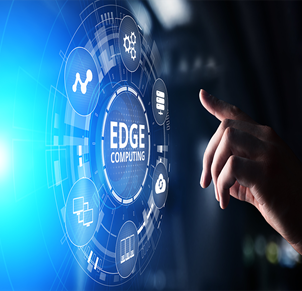Edge Computing: Extending the Reach of Cloud Services

Introduction
In the current interconnected world, where data is produced at a rate never seen before, the demand for real-time processing and low-latency responses has never been higher. Traditional cloud computing, while powerful and scalable, often falls short in meeting these requirements due to inherent limitations in network latency and bandwidth. Enter edge computing, a paradigm-shifting approach that brings computing resources to the source of the data, thereby overcoming the challenges of centralized cloud architectures. In this blog post, we’ll explore how edge computing extends the reach of cloud services, revolutionizing industries and enabling innovative applications.
The Rise of Edge Computing
The use of edge computing has completely changed the way that data is processed and analysed. Instead of depending on centralized data centres that are remote from end users, edge computing puts computational resources closer to the data source. This is how it differs from standard cloud computing. This closeness lessens the need for data to travel large distances over the network and lowers latency. Edge computing is therefore perfect for applications that need fast reactions, including augmented reality, driverless vehicles, and the Internet of Things, since it allows real-time processing and analysis.
Key Components and Architecture
At the heart of edge computing are edge devices, which include sensors, cameras, and other connected devices that generate data. These devices are equipped with computing capabilities, allowing them to perform basic processing tasks locally. Edge servers, located closer to the edge devices, further augment processing power and storage capacity. Together, these components form a distributed architecture that complements traditional cloud infrastructure. Data flows seamlessly between edge devices, edge servers, and the cloud, ensuring that processing tasks are performed efficiently and responsively.
Applications and Use Cases
The versatility of edge computing enables a wide range of applications across various industries:
- IoT: Real-time analytics and IoT decision-making are made possible by edge computing devices, optimizing operational efficiency and enabling predictive maintenance.
- Smart Cities: By deploying edge computing infrastructure throughout urban areas, Cities can improve traffic control, raise public safety, and resource allocation.
- Healthcare: Medical imaging analysis, telemedicine, and remote patient monitoring are made easier by edge computing, delivering critical healthcare services with minimal latency.
- Retail: Retailers leverage edge computing for inventory management, personalized marketing, and cashier less checkout experiences, enhancing the customer shopping experience.
Edge Computing’s Advantages
Edge computing offers several benefits over traditional cloud computing:
- Low Latency: Edge computing guarantees faster response times and lowers latency by processing data closer to the source, which is essential for applications demanding real-time interaction.
- Bandwidth Optimization: By minimizing the need to send massive amounts of data to centralized data centres, edge computing helps to maximize bandwidth utilization while also lowering network congestion.
- Resilience: Distributed edge architectures are inherently more resilient to network outages and disruptions, ensuring continuous operation even in challenging environments.
Challenges and Considerations
Although edge computing has many benefits, there are a number of drawbacks:
- Management Complexity: Deploying and managing distributed edge infrastructure can be complex, requiring careful orchestration and coordination.
- Security: Edge devices are often more vulnerable to security risks, making strong security measures necessary to protect private information and stop illegal access.
- Interoperability: Ensuring interoperability and compatibility between edge devices and cloud services can be challenging, requiring standardization efforts and open protocols.
Future Outlook and Trends
Looking ahead, the future of edge computing is bright, with several trends shaping its evolution:
- Edge AI: Intelligent decision-making and autonomous operation are made possible by the integration of artificial intelligence (AI) capabilities at the edge, opening up new possibilities for edge-enabled applications.
- 5G Connectivity: The rollout of 5G networks promises to further enhance the capabilities of edge computing, enabling ultra-low latency and high-bandwidth communication, ideal for latency-sensitive applications.
- Standardization Efforts: Industry-wide standardization efforts seek to promote interoperability and compatibility between edge devices and cloud services, driving adoption and innovation.
Conclusion
A new generation of apps and services is made possible by edge computing, which signifies a paradigm shift in the way we handle and analyse data. It also expands the reach of cloud services. Edge computing provides reduced latency, bandwidth optimization, and better resilience by moving processing resources closer to the data source. This makes it perfect for applications that need to respond and interact in real time. Edge computing’s influence on various industries will only increase as it develops and matures, spurring innovation and changing the digital environment.
Web References –
- 1. Srirama, S. N. (2024). A decade of research in fog computing: Relevance, challenges, and future directions. Software: Practice and Experience, 54(1), 3-23.
- Korontanis, I., Makris, A., & Tserpes, K. (2024). A Survey on Modeling Languages for Applications Hosted on Cloud-Edge Computing Environments. Applied Sciences, 14(6), 2311.
- Silitonga, D., Rohmayanti, S. A. A., Aripin, Z., Kuswandi, D., & Sulistyo, A. B. (2024). Edge Computing in E-commerce Business: Economic Impacts and Advantages of Scalable Information Systems. EAI Endorsed Transactions on Scalable Information Systems, 11(1).
- Kokate, S., & Shrawankar, U. (2024). Integration of the Cloud with Fog Computing to Secure Data Transmission between IoT and Cloud. In Integration of Cloud Computing with Emerging Technologies (pp. 83-92). CRC Press.
- Hiran, K. K., & Dadhich, M. (2024). Predicting the core determinants of cloud-edge computing adoption (CECA) for sustainable development in the higher education institutions of Africa: A high order SEM-ANN analytical approach. Technological Forecasting and Social Change, 199, 122979.
- George, A. S., George, A. H., & Baskar, T. (2023). Edge Computing and the Future of Cloud Computing: A Survey of Industry Perspectives and Predictions. Partners Universal International Research Journal, 2(2), 19-44.
- Das, R., & Inuwa, M. M. (2023). A review on fog computing: Issues, characteristics, challenges, and potential applications. Telematics and Informatics Reports, 10, 100049.
Dr. Virendra Singh Kushwah
B.Tech Computer Science & Engineering ( Cloud Computing and Automation).


